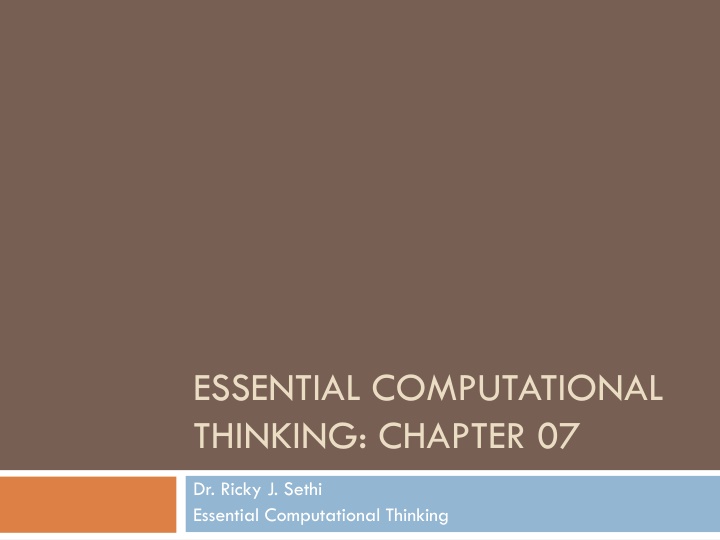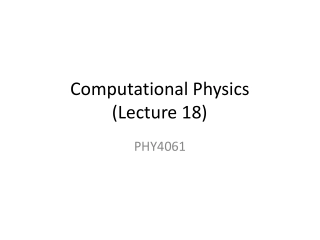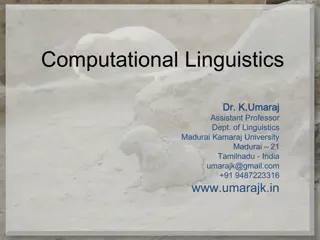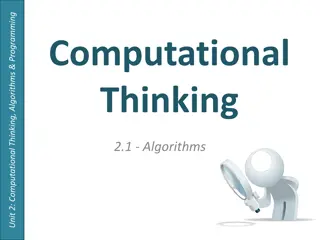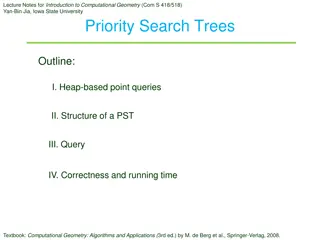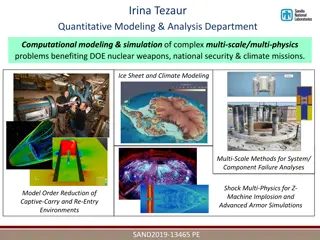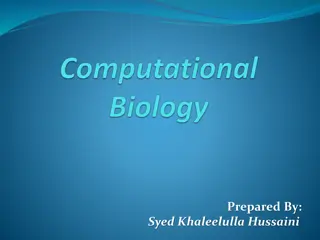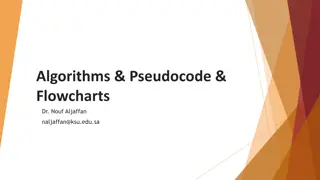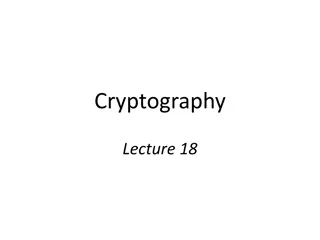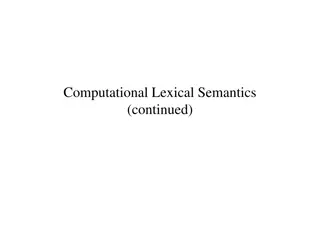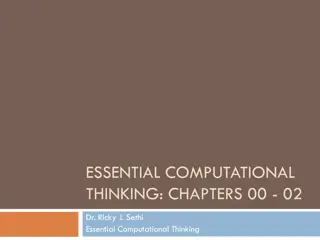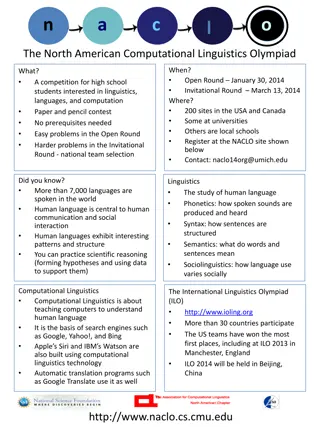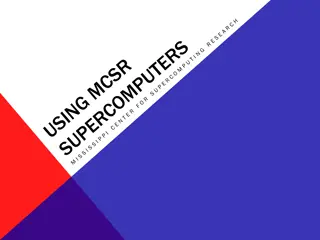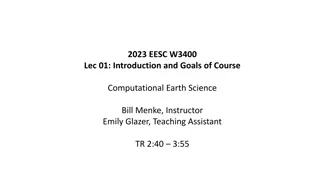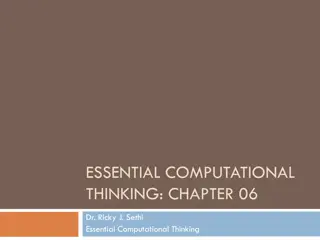ESSENTIAL COMPUTATIONAL
In Chapter 7 of "Essential Computational Thinking" by Dr. Ricky J. Sethi, dive into procedural programming concepts like sequence, selection, and iteration to craft computational solutions. Explore how engineers approach problem-solving in software development, emphasizing efficiency and abstraction levels. Discover the power of sub-routines, procedures, and functions in enhancing programmatic solutions. Unearth the fundamental elements of Python and the need for complexity management in programming.
Download Presentation

Please find below an Image/Link to download the presentation.
The content on the website is provided AS IS for your information and personal use only. It may not be sold, licensed, or shared on other websites without obtaining consent from the author.If you encounter any issues during the download, it is possible that the publisher has removed the file from their server.
You are allowed to download the files provided on this website for personal or commercial use, subject to the condition that they are used lawfully. All files are the property of their respective owners.
The content on the website is provided AS IS for your information and personal use only. It may not be sold, licensed, or shared on other websites without obtaining consent from the author.
E N D
Presentation Transcript
ESSENTIAL COMPUTATIONAL THINKING: CHAPTER 07 Dr. Ricky J. Sethi Essential Computational Thinking
Chapter 7 Procedural Programming
Story so far Data Representation + Algorithms = Computational Solutions Algorithms can be made of three control structures: Sequence Selection Iteration Use these to solve any computable function!
Engineer this! We can often solve the same problem in multiple ways Suppose we want to move a chair: We could run a few laps around campus before actually moving it Or we could just directly move it One approach is certainly more efficient than another Engineering ideas applied to Software Development Software Engineering! Done by people like Margaret Hamilton at NASA
Abstraction! One way to make solutions more efficient is to increase the level of abstraction E.g., in the moving chair example, if the room has projectors, windows, etc., we can simply ignore them But we would likely keep track of the tables and chairs as they might get in your way!
Sub-routines, Procedures, and Functions We can increase the abstraction in our programmatic solutions, as well! We can package our code into manageable pieces to make it more general We can use sub-routines or procedures or functions! Technically not synonyms as we ll see in a bit!
Up to now So far, we have mainly seen only the most fundamental elements of Python: values, variables, and control structures We often combined them into expressions and statements and used additional data structures like lists; we also used built-in commands or functions like input() and print() In theory, these are the only instructions needed to write any program From a practical point-of-view, however, these instructions alone are not enough The problem is one of complexity; e.g., some applications contain over 10 million lines of code
Sub-routines Dividing a program into manageable pieces is a way to manage complexity These manageable pieces are called sub-routines This is another form of abstraction since it gives us a more general, less detailed view of a system A sub-routine is essentially a named group of instructions for performing some task Sub-routines can be invoked (called) as many times as needed in a given program Sub-routines provide the opportunity for code reuse Sub-routines are fundamental building blocks in software construction since parts of the system do not have to be created from scratch as sub-routines can be re-used
Making lunches! E.g., my kid likes to have PB&J for lunch every day! Lunch has varying elements (carrots, cookies, etc.) but always PB&J I know I have to do that process or routine every day! Every time I make lunch, some parts of the process vary But when it s time for PB&J, I know exactly how that procedure goes
Same with Python! I can define a procedure, or function, to make the sandwich: def makePBJ(PB, Jelly, Bread): Put PB on Bread Put Jelly on Bread Cut into squares Now I can make lunch like this one day: Get carrots makePBJ(Skippy, Farms, Wonder) And on another day: Get cookies makePBJ(Skippy, Farms, Wonder)
Morning has broken We Imagine you have a set routine every morning: you wake up, curse the alarm clock, and stumble out of bed, directly en route to the kitchen You grab the nearest can of coffee grounds, boil some water, add the coffee grounds, and guzzle the resulting caffeine-induced nectar before finally waking up enough to realize it s Sunday and you didn t need to be awake at this ungodly hour anyway We can illustrate this daily routine below:
Functionalize! A single entity that encapsulates a number of steps is referred to as a subroutine or procedure or function in computer science In this context, you can think of a function as just a name for a particular sequence of instructions For example, we might refer to the sequence of steps in our daily routine as CoffeeMaker This is a kind of abstraction and, once you ve defined a CoffeeMaker function, you can just use the name CoffeeMaker everywhere you d normally utilize that entire sequence of instructions just as you do when making some coffee in your morning routine A function in computer science is slightly different from a function as defined in mathematics We ve seen before that a mathematical function can be thought of as some process that takes an input and maps it to an output.
Sub-routines, Procedures, and Functions, oh my! In imperative languages: A sub-routine is a (usually named) sequence of instructions to perform some task that is encapsulated as a single unit A procedure is a sub-routine that can possibly take some input, can have a side- effect, but does not return a value as output 1. A side-effect in computer science means anything that changes something, like changing a variable s value, writing to a file, reading from a file, sending data to a display, etc. A function is a procedure that does return a value, where the output value returned can be different on different calls to that function 1. There are subtle distinctions that can sometimes be drawn: e.g., you might have a pure function which always returns the same value on all calls for some specific input and does not produce any side-effects 1. 2. 3.
Functions in general Notice we start off by first defining the function and then, when the program itself starts, we can call, or invoke, the function as many times as we want We also follow the functional notation from algebra and use parentheses after its name (CoffeeMaker()) to denote a function or procedure, with the input listed within the parentheses: CoffeeMaker(COFFEE_GROUNDS) The input is referred to as the function s parameter We can further draw a distinction between the parameters in the function s definition (called formal parameters) vs the parameters that are passed to the function when it s called or invoked (these parameters are called the actual parameters or the arguments)
Functions in Python In Python, things work the same way We first define the procedure or function, using the Python keyword def We can then call, or invoke, the procedure as many times as we wanted using functional notation, by using parentheses after the name of the procedure: print_the_chorus()
Story so far Functions are an initial attempt at modularization There is a trend of increasing abstraction in higher and higher levels of programming E.g., OOP is also this kind of modularization/abstraction
Basics Python already understands some keywords or commands print() went from being a statement (in Python 2.x) to being a function (Python 3.x) It also understands values like numbers, strings, etc. And it uses Functional Notation, just like in Algebra
Functions are also just like in Algebra A function has a name (identifier) and arguments or parameters: Assignment Operator y = f(x) Variable Function name: f Function argument/parameter: x
Defining Functions A function header starts with the keyword def, followed by an identifier (like print), which is the function s name The function name is followed by a comma-separated, possibly empty, list of variable identifiers called formal parameters, or simply parameters , within parentheses ,(), followed by a colon ( : ) Following the function header is the function body, a program block containing the function s imperative statements As with all blocks in Python, the statements must be indented at the same level, relative to the function header def f(z): return z*z x=5 y=f(x) print(y)
Function Invocation Every function must be defined before it is used, or called, or invoked Functions are generally defined at the top of a program The actual values passed to the function are called actual parameters, or arguments
Value-Returning Functions A value-returning function is a function that s called for its return value, just like a mathematical function: f(x) = x*x In this notation, x stands for any numeric value that function f() may be applied to f(2) = 2 x 2 = 4 Value-returning functions in Python are similarly used Their call, or invocation, is replaced with their final value
Value-Returning Functions A value-returning function is a sub-routine called for its return value, and is therefore similar to a mathematical function, e.g., y = f(x) = x*x DEFINITION In this notation, x stands for any numeric value that function f may be applied to, y = f(2) = 2 x 2 = 4 INVOCATION/CALL y = f(4) = 16 Functions in Python are similarly used: Symbol Table on next slide to keep track of them!
Symbol Table X = f(1) X = f(10) Symbol Table Below Variable Name Value N1 1 N2 4 N3 10 X 1 X 100
Function Composition 24 You can use function composition just as in mathematics: So you can have calls like: print( format(value, format_specifier_string) ) y x f y= f(x) z y x g f z=g(f(x))=g(y)
Video Video on Socratica: Python Functions: https://www.youtube.com/watch?v=NE97ylAnrz4 Functions in CS are just like in math: functional notation In the beginning, are they using a shell/interpreter or a program/file? Function Definition vs Function Invocation/Call/Execution
Parameters/Arguments Formal parameters vs Actual parameters/Arguments Values are passed FROM arguments TO formal parameters, which are just local variables Function Signatures: no default arguments in most other languages and they use the Data Type of the formal parameters in the function signature KeyWord Arguments == Default Arguments are the named arguments and must have a name=value part in formal and actual invocation
Exceptions Video on Let's learn Python: Exceptions: https://www.youtube.com/watch?v=hrR0WrQMhSs
